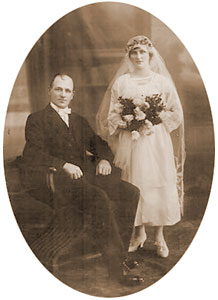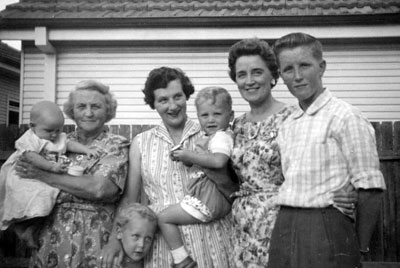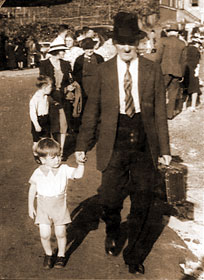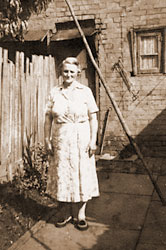Andrew James Dwyer (1888-1948) and Ethel Mary Ramsdale (1895-1974)
Andrew James Joseph Dwyer was born in Dryburgh Street, North Melbourne on 28 January 1888, the first child of William Dwyer and Margaret McCraith. At that time North Melbourne was a predominantly working class area with most of the population employed in local industry. Andrew probably attended state schools, Catholic schools being most likely beyond the means of the family, from age 6. State school education at this time has been described as involving …formal unimaginative teaching, crowded, ill-equipped classrooms and strict discipline [Larson (1994)]. Although strictly speaking children were required to stay at school until they were 15, most urban children left school at around 13 or 14. Andrew was probably already in the workforce before his father died in 1903.
We know from his future wife Ethel Ramsdale that Andrew:
…went to work at Vincents dairy out Malvern way…he also worked a lot in the Country Areas & learned a lot about wool rolling & wool classing etc & it turned out to be very useful in the years to come. The managers on the stations used to call on him in shearing times & complimented him on his ability.
On 9 October 1907 Andrew Dwyer married Sarah Jane Collis (1885-1920) at St. James Congregational Church, 101 Gore Street, Fitzroy. At the time of marriage Andrew was a labourer living at 23 Howard Street, North Melbourne. Andrew and Sarah’s only child, Violet Dorothy Dwyer, was born on 1 May 1908, suggesting that the marriage was probably the result of the pregnancy. Both Andrew and Sarah stated on their marriage register that they were 22 years of age, but Andrew was only 19 and presumably had to lie about his age. He also registered the marriage under the name James Joseph Dwyer, perhaps to provide anonymity.
The 1909 electoral roll has Andrew and Sarah (shown as Jane Dwyer) living at 96 Perry Street, Collingwood, which was actually the home of Sarah’s parents, George and Agnes Collis. By 1910 Andrew and Sarah had separated. It is presumed that Violet lived with her mother. In 1917 Andrew was living in Tennyson Street, Sandringham and Sarah in Currie Street, Collingwood. In 1919 Sarah was living at 18 Stanley Street, Collingwood, apparently as the sole adult occupant.
On 5 February 1917 Andrew applied to enlist in the Australian Imperial Force. In his papers he was described as being 29 years of age, 5 feet 7½ inches tall, weighing 139 lbs. and with an expanded chest measurement of 35 inches. He had a “fresh” complexion, blue eyes and light brown hair, with a mole on his left ear and a small birth mark on his chest. He was still married to Sarah, though they had not cohabited for seven years. Andrew requested his army separation allowance be paid to his mother, Margaret Bedford, for the benefit of his daughter Violet.
Andrew was passed as medically fit for service (though requiring dental attention) and went first to the Recruitment Depot at Royal Park before being transferred to the Australian Army Service Corps 1st Depot Battalion at Langwarrin on 12 March as a cook. On 20 March he was transferred to Broadmeadows, but was discharged on medical grounds on 28 May after an effective period of service of only 113 days. His discharge was due to an injury he received almost seven years before – “while swimming a horse (with his boots off) he landed on a broken glass bottle which severed the tendons of the sole of the left foot…Entrance of old wound of sole of left foot which has been divided and sutured Locomotion lessened”. Andrew went back to civilian life as a driver.
Ethel Ramsdale was born in Carlsruhe, Victoria on 13 March 1895, the second child and daughter of William Charles Ramsdale (1865-1941) and Johanna Boyle (1866-1954). Carlsruhe was a small rural town established in the 1850s about 6½ kilometers southeast of Kyneton. The Ramsdales had lived in Carlsruhe since James Ramsdale (1838-1872) came to Australia from Lancashire in the 1850s. Ethel wrote that she lived in Carlsruhe for “many years”, eventually moving “…to a lovely little cottage in Kyneton near the Kyneton Hospital in Simpson St.”
We are fortunate that Ethel has left handwritten notes about the family history which she wrote for two of her grandchildren in the early 1970s. This includes a description of her early life:
I was the boy of the family as Dad used to be on relay work which took him away from home & as he used to bring in loads of wood as all we had in those days were wood stoves & I used to chop & stack the wood. We went to school at Kyneton & while at school I used to do a small milk run on foot carrying the milk in billies hooked on to large billipies, & used to make some money for home use. Charlie [youngest brother] was born at this cottage [in Simpson Street], & had two bouts of pneumonia while young, but Mrs Burnell [landlady] looked after him & they cured him & he hadn't to go to hospital. Then my father got permanent work on the railways by getting through exams & that entitled him to a house free of rent & free holidays which took them anywhere with family all area Victoria & Mum eventually shifted to Carlsruhe R[ailway] Station & we were much better off financially.
Ethel’s son William has also documented what he knew about Ethel’s early life:
I know nothing to suggest that she had anything but a normal (unspectacular?) early life as a country girl in a somewhat remote area. I suspect, however, that she may well have acquired – or been assigned – an unusually responsible role (for a second child) in caring for her siblings and the household’s operations. She evidently walked a long distance for her schooling (in Kyneton) and may have tended to be tom-boyish – she often remarked to me, I recall, that she was invariably bare-footed; casting off her shoes/boots at every opportunity. I do also recall my father informing me at one time (and, I believe, her confirming on occasion) that she was fleet of foot as a youngster. It appears that in her early teens (?) she was quite swift as a barefoot runner who, at country picnic meets in the district, could outrun the males. So well reputed was she for this skill that not inconsiderable sums of money would change hands, I have been led to believe, as a result of her performances in mixed sex races conducted on a handicap basis.
One thing appears to be certain and that is that she was trained – or became naturally skilled – in the domestic service arts and her abilities there served her well in securing employment (no doubt in trying times) and regular work later on. It appears that she must have worked in domestic service situations in her early working life in and around Kyneton…
In 1919 Ethel left Kyneton for Melbourne, as she recounted in her handwritten notes:
I left my home town in Autumn, in about the year 1919 to make my fortune in the Big City. My sister Mary had previously married & lived in North Melbourne. I missed her very much as we were very good pals all our lives, starting from when we were at School & when we made our first debut by appearing in the school concert as the 2 little girls in blue. We sat one each side of the stage; one as dark with black hair & I as fair with blue eyes, while the rest of the school sang the old song, Two little girls in blue lads [probably the 1893 song “Two Little Girls in Blue” by Charles Graham]. I procured a situation at a butchers as maid & looking after the children, while the husband & wife attended the shop which, by the way, was all on the premises. While at this place I got acquainted with Mrs Barnes' cousin by marriage [Mary “Sis” Dwyer] who used to visit us & that was how my romance started as Sis had a brother, Andrew. I met him when I used to visit Sis in North Melbourne. It was a pretty short courtship & eventually Andrew & I married.
 The marriage took place at on 30 December 1920 at the Church of Our Lady of the Rosary, Kyneton (their wedding portrait is on the right). At the time of the marriage Andrew was a driver of 231 Peel Street, North Melbourne and Ethel lived at Hampshire Road, Sunshine.
The marriage took place at on 30 December 1920 at the Church of Our Lady of the Rosary, Kyneton (their wedding portrait is on the right). At the time of the marriage Andrew was a driver of 231 Peel Street, North Melbourne and Ethel lived at Hampshire Road, Sunshine.
Andrew and Ethel had three children together:
- Margaret Mary Josephine (1921-2004) – She married Victor Aitken on 24 December 1941 in Sydney, and they had two children together, Glenn Victor (b.1943) and Lindsay Robert (b.1946). Victor died in Sydney on 25 November 1981, after which Margaret moved to The Entrance, NSW, where she died on 10 December 2004 in hospital recovering from influenza and pneumonia.
- William Charles , our father (1934-2001) – He married Joan Therese Rogers on 4 February 1956 and they had six children together: Anthony William (b.1956), Phillip Joseph (b.1958), Catherine Margaret (b.1959), Michael Edward (b.1962), Jennifer Anne (b.1966) and Helen Maree (b.1967). William and Joan originally lived in Sydney (Randwick, Five Dock and Panania), but between 1966 and 1968 lived in New York, USA while William worked for the United Nations. Back in Australia, the family settled in Canberra, ACT. William died in Canberra on 5 August 2001 and is buried at the Gungahlin Cemetery.
- Vincent Francis (1937-2005) – He married Mary Philomena Bond in Sydney in 1957 and they had three children together before divorcing around 1966: Steven Charles (b.1958), Lynette Therese (b.1960) and David Anthony (b.1963). Vincent then married Catherine Mary Baxter and they had four children together: Bradley Charles (b.1972), Clayton Andrew (b.1975), Andrew John (b.1976) and Benjamin Lindsay (b.1979). Originally a resident of Sydney, Vincent also lived in Port Moresby, New Guinea, and Albany Creek (1977) and Emerald (1980), both in Queensland. Vincent died at Hatton Vale, Queensland on 26 December 2005.
The thirteen year gap between the birth of Margaret and the birth of William was reportedly due to a miscarriage that Ethel suffered after the birth of Margaret when she was either struck by a Melbourne tram or stumbled while alighting from one. Told that she would have no more children, the arrival of William when she was in her 39th year was surprising. The birth of William was difficult, however, and both baby and mother were at serious risk during delivery.
Ethel’s notes never mention Violet, Andrew’s daughter by his first marriage. It is unknown if Violet ever lived with Andrew and Ethel even though she was only 12 years of age and motherless at the time of their marriage. Violet is noted on Andrew’s death registration as “Doris”, aged 36 (she would actually have been 40) and still living.
Ethel’s handwritten notes on the family provide some details of her and Andrew’s twenty-seven year marriage. Unfortunately very few dates are given and the chronology of the handwritten notes is confused, and made more so by having two separate, sometimes conflicting accounts of the same events. The electoral rolls, along with birth records for their children, provide some evidence of where Andrew and Ethel lived (or were at least registered to vote) and what their occupations were at various points in time, but do not provide a complete chronology.
During the 1920s Andrew was occupied in the milk industry. Initially he worked for a Mr. Hoggart in Collingwood, and soon supplemented his wage “by selling the skim milk and yodelling around the streets in the daytime”. In 1921 he had two small dairies, the first at the corner of Kent and Gardner Streets, Richmond, then another at an unknown location in North Melbourne. In 1922 he built a dairy at 43 Droop Street, Footscray which Ethel described:
[Andrew] bought a cottage…there for £800, & built a dairy. He called tenders for the Dairy & a returned soldier was from W. War I & he built a lovely stone dairy Andy had it painted in his favourite pale blue & the grey stone & blue looked very smart.
…The grounds in Droop St. was ideal for the Dairy. It had stables at the back of a lovely paved yard, grapevines climbing over a trellis which stretched from Dairy to Stables. We used to keep the dairy & stables like a new pin Andy used to pick up all the straw & put manure in the manure pit & I used to hose the bricks till they shone like a kitchen floor.
…It was an ideal place as it had a side entrance for the customers…We used to sell clotted cream at the dairy we could sell any amount of it as well as ordinary cream. [Andrew] used to buy his milk mostly from the farmers & get it pasteurised at the Ice House in Footscray.
After a few years, Andrew’s health began to worry him so in 1925 or 1926 he sold the Footscray dairy to a man named Rich, and then took the family to Sydney. Things did not go well in Sydney, although Ethel did not know why, and the family soon moved back to Melbourne. There Andrew found that the Footscray dairy that he had sold to Mr. Rich was not doing well (Ethel said Rich was a bad businessman) so Andrew helped him to build the business back up so that Rich could sell it, which he did soon after. Andrew, Ethel and Margaret then moved once more back to Sydney, initially living at 26 Hereford Street Glebe.
Probably around 1929 Andrew contracted a bout of pneumonia requiring hospitalisation for “6 to 8 weeks” followed by recuperation in “Walker Home” (assumed to have been a nursing home of some kind). He suffered a collapsed lung, which probably explains why his son William remembered his father as being “in constantly poor health”, although Ethel says that his health was “never too robust”. This illness was followed in 1930 by a recuperative stint on Terlings Station, a sheep station near Moree. Andrew worked as a station hand and Ethel as a cook.
Later in 1930 the family once more returned to Sydney. Andrew started a milk delivery business at 47A Pittwater Road, at first with a partner named Jim White and then on his own. Andrew again sold milk by yodelling through the streets of Manly and Balgowlah. With the Depression worsening, Ethel arranged for her sister Ellen (“Nell”) to work in the dairy while Ethel took a job as a cook in the City “as our rent was fairly high”. By 1933, however, the Depression and, according to Ethel, New South Wales Premier Jack Lang’s “drastic measures” to deal with it, meant that Andrew had to sell his milk runs to the Northern Milk Company.
In 1931 the family moved to a house at 60 Whistler Street Manly, but Ethel’s notes indicate that work was very hard to come by. As a result, Andrew and Ethel (with Margaret) spent time working at Piallaway Station near Tamworth, but “after getting a thorn in [Andrew’s] hand which poisoned it we came down to the City again.” They appear to have later worked once more at Terlings Station at Moree, with Andrew working as a milk groom and Ethel as a cook for £2 10s. per week. Ethel says that they also worked at Serumlo Station near Singleton.
The family was permanently back in Sydney by 1934, when William was born. They lived in a number of houses in Bridge Road, Glebe over the next ten years (numbers 270, 174 and 205). William described the accommodation at 205 Bridge road:
I assume they moved there – a bedroom and a bed sitter apartment at street level in the front – shortly after I arrived. There were several flats on, I think, three levels [the building still stands and has two levels above the street and a basement level below] and we shared bathroom, toilet and laundry facilities with the other flat dwellers…The laundry facilities (basement level) were very basic and the one seater toilet was “way down” the back yard…
The 270 Bridge Road house seem to be of a similar type, but the 174 Bridge Road house has since been redeveloped and its configuration is unknown. There are photos of the Glebe houses in Ethel's memoirs.
Around 1946-47 Andrew, Ethel and their sons moved to 5 Albert Street Erskineville (see photos), which Margaret, her husband Victor Aitken and their two sons had recently vacated. This was a narrow single-level house within a stone’s throw to the railway line between Newtown and Macdonaldtown stations. William again described this house:
Here we had, as renters, a master (front) bedroom and a second (which Vince and I shared); a dining room/kitchen, a laundry (sporting a large copper for clothes washing and for heating bathwater) and a cubicle bathroom – all of these on a single level. The toilet was, once again, at the rear of a small and short backyard but, catering for only four people in the one family, was an unheard of… luxury.
From 1934 Andrew’s occupation was recorded as “labourer” in the electoral rolls, indicating his final break with the milk industry. Just how often he worked in his later years is uncertain. William recalled that Andrew was often ill or incapacitated, but said that:
…[Andrew] did pursue – perhaps in an itinerant fashion – the work of a house to house purveyor of home delivered (by horse and cart – both on daily hire) fruit, vegetables, eggs, etc. etc. I would, on occasion, assist – if only to tend the horse and the produce whilst he dropped in to the “doctor” for some “medication” – and, upon further reflection, there may have been a time, or times, when milk and cream were optional products of the day. I also seem to recall that, in general, he was a good talker and affable vendor – well liked and received by his clientele. I do not recall him yodelling to announce his arrival in areas in which he plied his trade in those days, though he did have a loud and lyrical call to alert potential (and regular?) clients to his arrival. I do know that, when he was involved in any regular work, he would come home at the end of the working week with small treats – usually comics, for Vince and me.
Ethel says that after Vincent was born in 1937 she worked as a cook at Mockbells, a family style restaurant in Martin Place in the City, where she stayed for sixteen years. She then worked at Vicars, a textile factory in Marrickville, as a machinist/weaver until she was retired on age grounds. She later worked at the Church of England Hostel in Camperdown, “doing breakfast for about 60 [female] students from the various universities Sydney & N.S.W.”
William claimed to have known little about his father Andrew. He said that Andrew suffered from severe asthma, but was by his recollection a heavy smoker of roll-your-own cigarettes and that he often drank to excess. He was not a church-going man, and loyal to his Irish roots was anti-Monarchy and anti-English. He was sports-loving and an occasional punter. He was generally known as and referred to as “Joe”, but Ethel always called him “Andy”. She was often known as “Et”. Andrew and Ethel did not have a wide circle of friends, and their closest relatives all lived interstate.
|
|
Andrew died aged 60 on 23 December 1948 at the Royal Prince Alfred Hospital, Camperdown. The cause given was congestive cardiac failure and pneumonia. He was buried on 24 December in the Roman Catholic section of Rookwood Cemetery. He apparently left no will or inheritance for his widow and dependent children, but equally left them no significant debts.
Ethel continued to live at Albert Street Erskineville until about 1956 when she moved to a similar semi-detached cottage at 57 O’Connell Street Newtown (see photo). This cottage had a green wrought iron fence and gate at the front leading on to a narrow porch along the front of the house. Inside there was a sitting room at the front with a dark, narrow and squeaky-floored corridor which ran past a single bedroom on the left to a dining room. A step down took you into a kitchen/laundry/bathroom area with a door out to the back. The flushing toilet was in the back right-hand corner of the backyard. On either side were similar houses, but over the back fence was a rusty corrugated iron structure – some sort of workshop, perhaps – that towered over the small backyard. Ethel apparently slept in the sitting room, Vincent occupying the bedroom until his marriage in 1957, and Ethel thereafter feeling safer sleeping at the front of the house.
 Above L-R: Cathy Dwyer, Ethel, Anthony Dwyer, Joan Dwyer (nee Rogers), Phillip Dwyer, Margaret Aitken (nee Dwyer) and Lindsay (Margaret's son). Right, clockwise from top left: Lindsay, Ethel, Cathy, Phillip, Anthony. April 1960, probably in the Aitken home at Birrong, Sydney. |
 |
Ethel remained independent throughout her widowhood, living simply on her modest government pension. She had some support from her children, particularly Margaret whose husband Victor Aitken worked for the Franklins supermarket chain. Ethel never had a telephone (despite offers from Margaret to have one installed and paid for) but had a television (only black-and-white in her lifetime) in the sitting room. She was indulgent towards her grandchildren when they visited, providing colouring books and paints/pencils on their arrival and hammers, nails and pieces of wood to keep them busy after lunch. Her ability to cook fabulous Sunday roasts on her small, green gas cooker probably owes much to her earlier life as a cook.
Ethel died in her eightieth year following a heart attack at the Royal Prince Alfred Hospital, Camperdown on 26 September 1974. The day before she had been feeling unwell and walked to the nearby hospital, having herself admitted and appearing at first to have been recovering. She left no will or legacy, but had small amounts of cash stashed in the house which apparently was sufficient to meet the costs of her funeral. A Requiem Mass was held for Ethyl on Saturday, 28 September at St. Joseph’s Church, Missenden Road Camperdown, and she was buried afterwards at Botany Cemetery.

